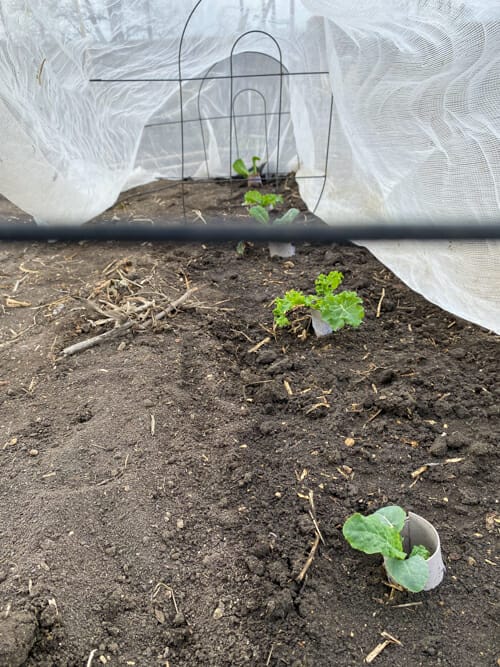How to Plant Kale in the Garden
Here’s how to plant kale so you can harvest fresh bunches all season long!

Also read: When to Plant What, Planning your Garden, Freezing Kale
Kale comes in several different varieties. I like to plant a few different coloured and textured varieties to keep the garden and dinner plate interesting!
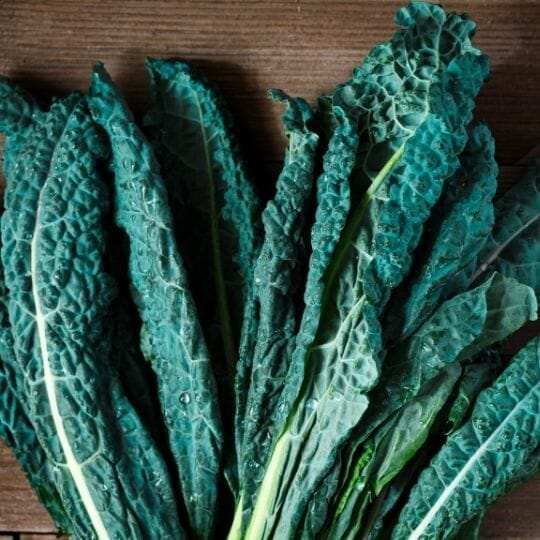
Kale is a Cool Weather Crop
First, things first – kale is a cool loving crop. That means it does best in the shoulder seasons when temps are cool – spring to early summer and late summer to fall. Here on the prairies that means May to early July and late August to October.
That’s not to say kale doesn’t grow in the summer, it does, but it is not at its best. It tastes less sweet, the leaves are tougher, growth is slower and pests like aphids, flea beetles and cabbage moths may leave it looking less desirable.
For best results, consider two plantings, one early spring and one early August for harvesting in the fall. You could also do one planting in spring, let it rest during the summer months and resume harvesting as the summer temps cool down. This is usually what I do. It works quite well because during the summer months, there are so many other veggies to eat that we don’t mind leaving the kale for later.
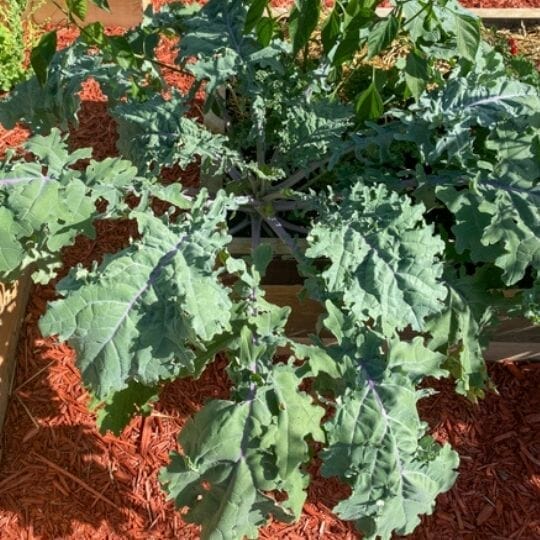
How and When to Plant Kale
Choose your favourite varieties and get planting early in the season.
DIRECT SEEDS OR TRANSPLANTS
Because kale grows fairly quickly you can seed it directly in the ground or start it inside and transplant it out. The choice is yours, maybe you even want to do a bit of both?
Direct seeding – expect to harvest within 50-75 days of seeding
Transplants – expect to harvest within 30-40 days of planting outside
WHEN TO START KALE – INSIDE AND OUTSIDE
Seeding kale inside – Start seeds about 6-8 weeks before last frost. Here in Winnipeg where our last frost date is May 24, start seeds indoors about the end of March.
Seeding kale outside – Direct seed in the garden about 2-4 weeks before last frost. End of April to early May here in Winnipeg.
Planting transplants outside – Before transplanting outside, harden kale seedlings off by taking outside for several days, each day adding a few more hours. Do this for five to seven days before transplanting to expose it to the conditions it will face in the garden – sun, wind, cold, rain and heat. This will prevent sun burn and overall shock from being moved from ideal indoor conditions to the harsh reality of outdoor life.
When to transplant – Transplant about 2-4 weeks before last frost (end of April to mid May) depending on the weather forecast. Watch for extended cold periods or extreme frost. Kale is hardy and can withstand some frosty nights, but if the overnight low is -4 to -6 or colder, I cover my young kale seedlings.
If you have a soil thermometer, the ideal soil temp is 10-30°C (50-85°F).
DAYS TO GERMINATION
Kale sprouts within in 7-10 days.
DAYS TO MATURITY
Direct seeded kale will be ready in 50 to 75 days depending on variety.
Transplants will be ready to harvest in 30-40 days depending on variety.
WHERE TO PLANT
Full sun is best, but kale will tolerate some shade, especially in the heat of summer.
SOIL PREFERENCE
Kale prefers well drained, fertile soil. Consider adding compost to the bottom of the hole when planting transplants. Cover soil with mulch to keep soil moisture in as much as possible.
SEED SPACING
Space seeds 1″ (2.5 cm) apart. Later, you’ll want to thin the kale plants so they’re 12″ (30 cm) apart and have good room to grow. Any plants you pull will be great in a salad.
Space transplants 12″ (30 cm) apart.
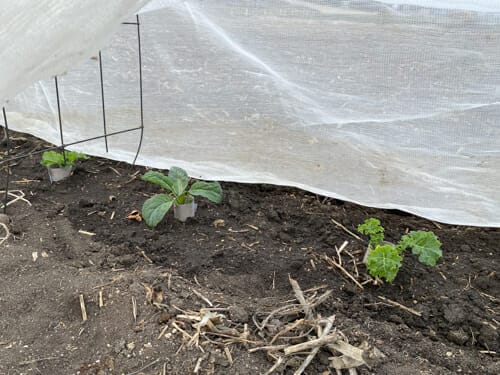
DEPTH OF SEED OR SEEDLINGS
Plant 1/4″ (6 mm) deep. Gently tap soil covering the seeds.
Plant transplants so the soil reaches the bottom of the first set of leaves.
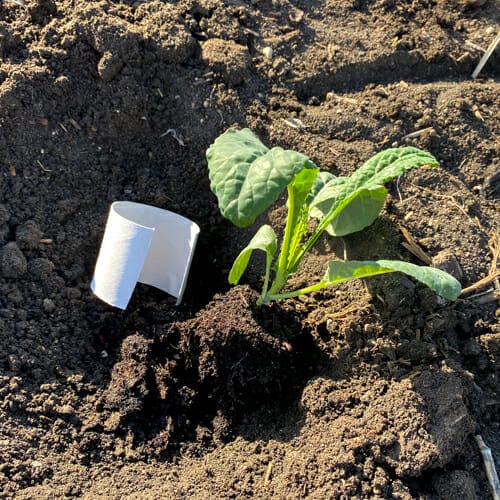
ROW SPACING
Space rows 18-24″ (45-60 cm) apart.
COMPANION PLANTING
Plant kale next to: chamomile, dill, mint, rosemary, sage
Don’t plant kale next to: eggplants, peppers, potatoes or tomatoes
SPECIAL TIPS FOR PLANTING KALE:
- Kale is part of the brassica or cabbage family. It is highly attractive to flea beetles and cabbage moths. Even early in spring, flea beetles can destroy kale plants over night. Be prepared by planting kale under row covers. These lightweight, tightly woven covers keep bugs out but allow sunlight and rain through. You can buy official row covers or bug nets to protect your crop or look for old tight sheer curtains at a thrift shop to do the same job. The row cover will also protect from the cabbage moth later in the growing season.
- My kale under a row cover fabric held up by some old garden frames. The sides of the row cover must be completely sealed.
- Young kale plants are also susceptible to cut worms. Again, a good offense is best. Cutworms curl themselves around the stem, so place a barrier around the bottom 1 inch of the stem into the soil a bit as well. I used toilet paper rolls sealed with tape. They won’t last forever, but cutworms are most active early in the season and the kale will be tougher when the rolls disintegrate.
- Water the seeds and young seedlings consistently for optimum growth – or hope for spring rains.
- Compost mixed into the soil is always a bonus.
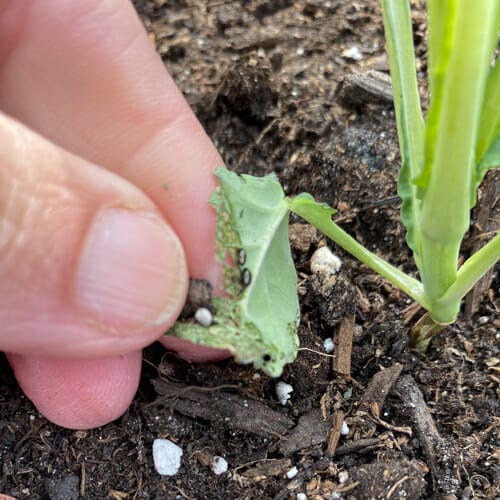
Here’s what it looks like in the garden when I’m done planting the kale.
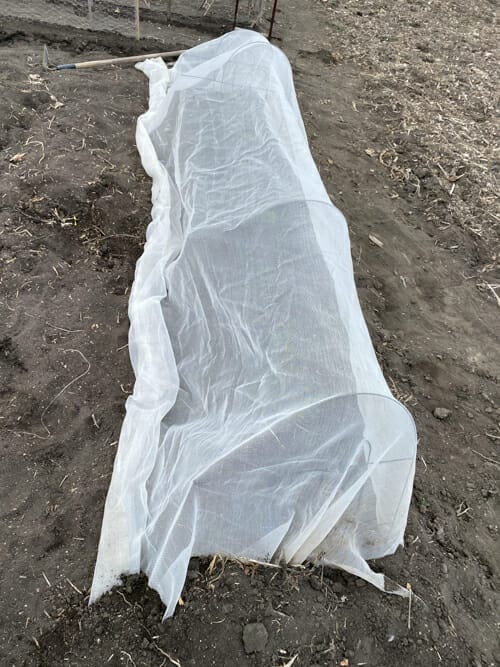
Are you growing kale this year? Do you have a favourite variety? What will you make with your kale?
Kale, Butternut Squash and Farro
Kale Slaw with Orange Yogurt Dressing
Italian Sausage, Kale and White Bean Soup
Pomegranate and Whole Grain Salad
Freezing Kale in Convenient Pucks
Here are a few other How To’s to get your gardening going:
When to Plant Different Vegetables
Share your favorite kale recipe in the comments below or share your photos and ideas with me on Instagram @getgettys or Facebook @GettyStewart.HomeEconomist.
Getty Stewart is a Professional Home Economist, speaker, frequent media guest and writer dedicated to putting good food on tables and agendas. She is the author of several recipe books on enjoying and preserving fruit, Founder of Fruit Share, a mom and veggie gardener.
Sign up to get articles by Getty delivered to your inbox. You’ll get recipes, practical tips and great food information like this.


